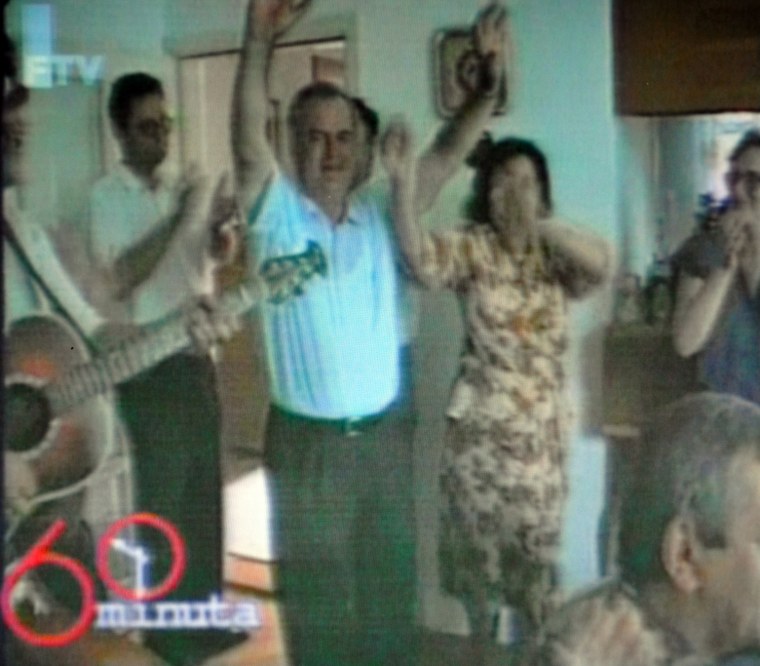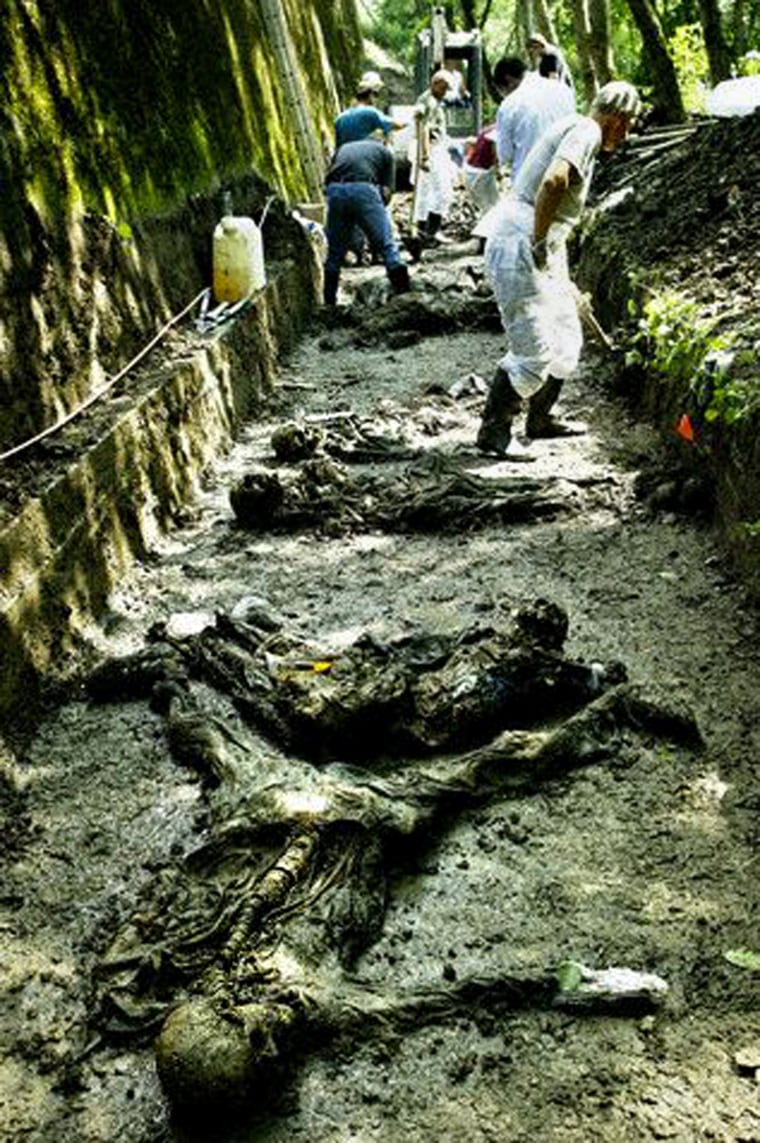How many times can you bury your child without going mad?
It's a question that has haunted hundreds of Bosnian mothers facing an agonizing dilemma: As researchers identify remains scattered around mass graves from the Srebrenica massacre, do they bury the first few bones or wait potentially years for a skeleton to come together?
Many choose to bury whatever fragments turn up first. Then another bone is found and they have to reopen the grave. Months later researchers find another piece, and then another — and each time, the women say, it feels like another funeral.
The identification mission being carried out by the International Commission of Missing Persons is a monumental task: More than 8,100 men and boys were killed over five days when Bosnian Serb forces overran a U.N.-protected enclave during the 1992-95 Bosnian war.
Newly identified Srebrenica remains are usually buried at a memorial center each year on the July 11 anniversary of the start of the 1995 massacre, Europe's worst slaughter of civilians since World War II. After the bloodshed — classified by the U.N. as a genocide — troops led by Gen. Ratko Mladic scattered the bodies in dozens of mass graves that still turn up today.
Ten years after a DNA lab took a drop of blood from Habiba Masic, researchers called her to say they had made a positive identification.
It reopened a new cycle of anguish.
More remains keep turning up
The man at the lab said they had found 90 percent of her husband's body. His bones had been dispersed among four different mass graves.
"And the children?" Masic recalled asking. "The man went silent, and I knew something was wrong."
She was told there was no trace of one of her boys but a small part of the other had been found. The problem was DNA analysis could not determine which one he was.
"I couldn't breathe," she said. "I couldn't speak."
Now, she cannot bury the precious fragment, for what would the gravestone say: Sadem Masic, 1976-1995? or Sadmir Masic, 1977-1995?
"Brother is now waiting for brother," she said.
Agency began after massacre
The ICMP, established in 1996 at the urging of former President Bill Clinton, has collected 87,049 blood samples from relatives of the missing, has analyzed their DNA profiles and is now matching them with DNA profiles extracted from the 29,185 bone samples that have been exhumed.
ICMP grew into the world's largest DNA-assisted identification program and so far investigators have helped identify 12,518 individuals in Bosnia. Out of those, 6,185 are Srebrenica victims.
The agency also carries out work in Chile, Iraq, Colombia, Norway, Kuwait and the Philippines. It helped identify victims of the Sept. 11, 2001, attacks on New York's World Trade Center and the remains of those who died in the 2004 Asian tsunami. But Bosnia remains its biggest operation.
During the war, the United Nations declared Srebrenica, besieged by Serbs throughout the conflict, a protected area for civilians. When Mladic's troops overran the enclave, people flocked to the U.N. base in the suburb of Potocari for protection.
Outnumbered Dutch U.N. troops never fired a shot. They watched troops round up the entire population, and take the men and boys away to be shot.
After the massacre, U.S. Secretary of State Madleine Albright waved satellite photos of mass grave sites at Security Council members. Washington knew what had happened and where the mass graves were, she told them.
Cover-up fragmented countless victims' bodies
Serb troops rushed to the sites with bulldozers and moved victims to other locations — now called 'secondary' mass graves — to conceal evidence of war crimes. As the machines plowed up bodies, they ripped them apart and now fragments of the same person can be scattered among several sites.
The ICMP found "one man in five different locations who came to us in 11 different body bags," says the head of the Sarajevo-based organization, Kathryn Bomberger. She believes the enormous cover-up should be considered another war crime.
One thing is certain: It created a forensic science nightmare. "This is the biggest forensic puzzle that exists anywhere in the world," Bomberger said.
Over a decade ago, when ICMP began its work in Bosnia, most pathologists, anthropologists and those in the forensic community said, quite simply, that what they were trying to do was impossible.
Nobody in the world had ever tried to find, exhume, identify and in many cases reassemble so many sets of remains — and then return them to families. Slowly, however, the researchers have made progress.
Remains often scattered across sites
At the ICMP Podrinje Identification Project in Tuzla, 45 miles northwest of Srebrenica, case manager Emina Kurtagic pushes a heavy morgue door to reveal aisles of blue and white body bags.
The 876 trays in the aisles were built to accommodate one body each. Instead, they hold a total of 3,500 bags, each with a few bones of one or more victims waiting to be identified and reassembled.
Remains of one of Habiba's sons are probably in here somewhere and won't be among the 600 victims to be buried at this July's memorial.

"About 12,000 bags passed through this room in the past decade," Kurtagic said. "Today, we just loaded 503 fairly complete and identified bodies on the truck. Those will be buried this year in Potocari and it's just part of this year's delivery."
At another facility, Cheryl Katzmarzyk, a senior forensic anthropologist, is trying to solve hundreds of other human jigsaw puzzles. She is running a department established to deal with the worst cases — those scattered over multiple sites.
On one table is a nearly complete skeleton. Just the head is missing. The one on the other table has only five bones.
"This case is more common," Katzmarzyk said. "Here we have approximately 20 percent of the skeleton of this man recovered. In fact, he was found in two different graves, his arm was found in one, his lower body, his legs, were found in another, mixed up within that grave."
Search goes on for genocidal Mladic
Mladic, indicted for genocide, is still in hiding, apparently somewhere in Serbia. Recently, television channels aired videos confiscated by Serbian police in one of his hideouts. They showed him dancing, singing at parties and cuddling his grandchild.
"Mladic is holding his granddaughter in his arm at a birthday party. And how do we feel?" Masic said bitterly.
It is hard to imagine anybody would envy Habiba Masic, but Rufeida Buhic does.
The 68-year-old's husband was killed early in the war. Serbs caught her only son, Razim, 17, when he tried to escape from Potocari. A massacre survivor told her Razim was one of the first to be shot. His body was never found.
Buhic returned to her prewar home near Srebrenica to be where the three lived together.
"That's where they walked, where they worked. That's where I want to walk," she said.
When neighbors see her working around the house and the garden all day, "They say, you really work too much. But I'm not alone, I tell them. The two are with me and are helping me."
Buhic can't sleep at night. No medication helps. Often she visits a neighbor's house, where her son's friend lived and where Razim once measured how tall he grew. She goes there just to look at the line carved in the wood of the doorway: 195 centimeters, or nearly 6-foot-5.
Constantly, she checks her mobile phone.
"Every time it rings, I think they are calling me to say they found him ... even one bone," she said.
